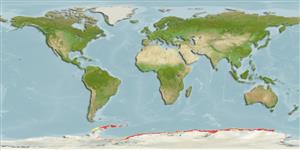Environment: milieu / climate zone / depth range / distribution range
Ecology
Marine; demersal; depth range 140 - 1405 m. Polar; 60°S - 78°S
Southern Ocean: East Antarctica (Ross Sea, Davis Sea, Queen Maud Land), South Shetland Islands and South Orkney Islands.
Size / Weight / Age
Maturity: Lm ? range ? - ? cm
Max length : 21.0 cm TL male/unsexed; (Ref. 5181); max. published weight: 131.00 g (Ref. 124149)
Individuals over 10 cm SL feed primarily on mysids and to a lesser extent on isopods. Fish below 10 cm SL feed almost exclusively on gammaridean amphipods (Ref. 5181).
Life cycle and mating behavior
Maturities | Reproduction | Spawnings | Egg(s) | Fecundities | Larvae
Eakin, R.R., 1990. Artedidraconidae. p. 332-356. In O. Gon and P.C. Heemstra (eds.) Fishes of the Southern Ocean. J.L.B. Smith Institute of Ichthyology, Grahamstown, South Africa. (Ref. 5181)
IUCN Red List Status (Ref. 130435)
Threat to humans
Harmless
Human uses
Fisheries: of no interest
Tools
Special reports
Download XML
Internet sources
Estimates based on models
Preferred temperature (Ref.
123201): -1.7 - 0.9, mean -0.5 °C (based on 552 cells).
Phylogenetic diversity index (Ref.
82804): PD
50 = 0.5000 [Uniqueness, from 0.5 = low to 2.0 = high].
Bayesian length-weight: a=0.00603 (0.00386 - 0.00941), b=3.25 (3.11 - 3.39), in cm total length, based on LWR estimates for this species & (Sub)family-body (Ref.
93245).
Trophic level (Ref.
69278): 3.3 ±0.49 se; based on food items.
Fishing Vulnerability (Ref.
59153): Low vulnerability (11 of 100).
